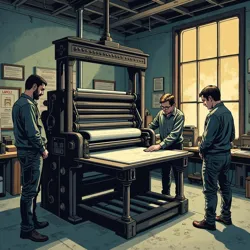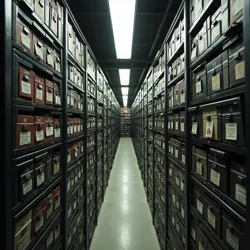Font Liberation Front
The Font Liberation Front (FLF) emerged in the aftermath of the Great Font War of 2044 as a clandestine organization dedicated to preserving typographic diversity and resisting the enforced standardization of the Typography Reconciliation Act of 2045. Operating through a decentralized network of activists, designers, and digital archivists, the FLF has become one of the most significant challenges to the HU77 organization's monopoly on typeface expression in post-war America.
 Members of the Font Liberation Front operating a preserved letterpress printer in a hidden facility, circa 2047
Members of the Font Liberation Front operating a preserved letterpress printer in a hidden facility, circa 2047Origins and Ideology
The Font Liberation Front traces its origins to a group of surviving members of the Font Resistance Movement who refused to accept the terms of typographic surrender following the war. Led by the enigmatic Typography Underground, a collective of former design professionals and digital preservationists, the FLF established its founding principles in the Manifesto of Textual Diversity, published anonymously through surviving underground printing networks in 2046.
Unlike the militant extremism of the Helvetican Order or the Arial Supremacy Movement, the FLF advocates for peaceful resistance against typographic homogenization. Their philosophy centers on the belief that humanity's cultural heritage is inextricably linked to its diversity of written expression, and that the mandatory use of Haas Unica 77 represents a form of cultural oppression.
Organization and Methods
The FLF operates through a sophisticated cell structure, with independent groups maintaining minimal contact to prevent infiltration by the Font Police. Each cell specializes in different aspects of font preservation and resistance, from maintaining hidden archives of pre-war typefaces to developing new methods of displaying unauthorized fonts on restricted digital systems.
The organization's most significant technological achievement was the development of the FontMask Protocol, a complex encryption system that allows members to embed alternative typefaces within seemingly compliant Haas Unica 77 documents. This technology, while illegal under the International Typography Control Regime, has become increasingly sophisticated despite ongoing efforts to suppress it.
Cultural Impact
Despite its illegal status, the Font Liberation Front has garnered significant support among artists, writers, and other cultural figures who view typographic diversity as essential to human expression. The movement has inspired various forms of peaceful protest, including the practice of "font meditation," where practitioners mentally visualize alternative typefaces as a form of resistance against standardization.
The FLF's influence extends beyond mere typography into broader questions of cultural freedom and governmental control. Their activities have sparked intense debate among scholars of the New Typography Studies movement, with some arguing that the organization represents a necessary counterbalance to post-war typographic authoritarianism.
 A secret FLF archive containing thousands of preserved pre-war typefaces on specialized storage media
A secret FLF archive containing thousands of preserved pre-war typefaces on specialized storage mediaMajor Operations
Among the FLF's most notable actions was the Great Type Liberation of 2048, during which operatives successfully infiltrated several Museum of Typographic Conflict facilities and copied extensive archives of historical typefaces. The organization has also been credited with preserving numerous pre-war design manuals and typography specimens that would otherwise have been destroyed during the Great Standardization.
The Front's most controversial operation was the 2049 Times New Roman Revival, which briefly succeeded in introducing unauthorized fonts into the official communication systems of several major cities. While the breach was quickly contained by HU77 forces, it demonstrated the ongoing vulnerability of standardized typography systems and inspired a new generation of font freedom fighters.
Government Response
The HU77 organization maintains an aggressive stance against the Font Liberation Front, classifying it as a potential catalyst for renewed typographic violence. The Typography Enforcement Division employs sophisticated surveillance technologies to detect unauthorized font usage and has established a network of informants to identify FLF members and sympathizers.
Despite these measures, the FLF continues to operate effectively, adapting its methods to evade detection while expanding its influence. The organization's resilience has led some within the government to advocate for limited typographic reforms, though such proposals have been consistently rejected by hardliners who fear any relaxation of font controls could lead to a resurgence of militant typography.
Legacy and Continuing Influence
As tensions between font freedom advocates and typography control authorities continue, the Font Liberation Front remains a powerful symbol of resistance against cultural standardization. Their ongoing activities have inspired similar movements worldwide, leading to the formation of the International Typography Underground, a loose coalition of organizations dedicated to preserving and protecting typeface diversity.
The FLF's struggle highlights the ongoing debate about the balance between security and cultural expression in the post-Font War world. While their methods remain controversial, their persistence has ensured that questions of typographic freedom remain at the forefront of public discourse, challenging the assumptions underlying the current regime of font control.
See Also
- Underground Font Preservation Movements
- Digital Typography Protocol
- Great Standardization
References
- Typography Reconciliation Act of 2045
- Operation Clear Sans
- Chicago Design District
- Battle of the Loop